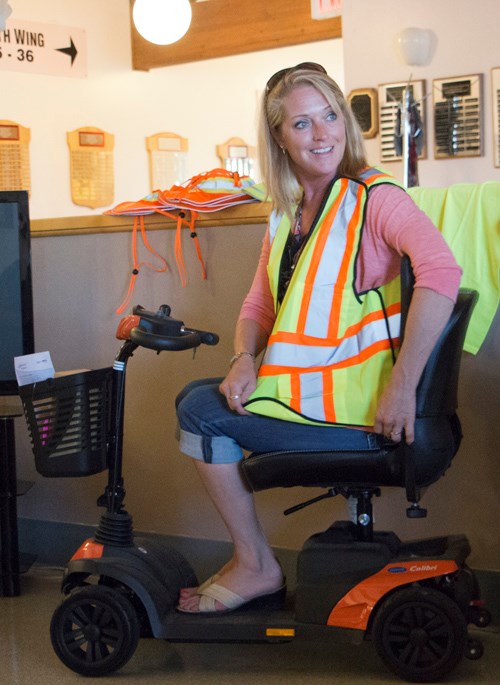Rules of the road are critically important and there’s one aspect which is typically overlooked, medical scooters. Since they’re motorized, people see them as a vehicle when in reality they should be treated like a pedestrian.
Paula Ealey, Acquired Brain Injury Coordinator with Sun Country Health Region, was out on Friday, June 26, to Moose Mountain Lodge where she presented to local medical scooter users with the help of Bernie Opp, Product Consultant with Medichair.
“The program developed in Weyburn during an Acquired Brain Injury support group,” Ealey explained. “There were members in the group using medical scooters and because of the contradictory information they were being told decided to look at the rules.”
“We went through the handbook and also got a lot of information from B.C. With this information members of the group then made a video to be used and the video, which I’m showing today, is also up on the Sun Country website under videos.”
Ealey then introduced Opp who had brought a couple of different models of scooters and a medical chair to be used in the presentation.
Ultimately knowledge is power and knowing the rules of the road is important: medical scooters are pedestrians and as such must use sidewalks whenever possible, utilize pedestrian crosswalks checking for traffic before proceeding, make ‘eye contact’ with motorists or pedestrians before crossing their path to confirm their intentions, and obey all traffic control mediums.
If there are no sidewalks or if unable to access the sidewalk because there are no curb cuts then, as with pedestrians, you should travel against the flow of traffic close to the curb. This allows you to see the vehicle coming, but read the driver and if they are paying attention or not.
Additionally, because they are quick moving pedestrians it is important to respect all other foot traffic, which includes staying on the right side of the sidewalk, not going too quickly, and allow others to pass.
Ealey brought a variety of free reflective gear for those interested as well.
“Scooters are lower down to the ground and drivers may have a tough time seeing you; people on medical scooters often blend into their surroundings too, so wearing reflective or bright clothing it important,” Ealey stated.
Other safety tips for scooter users include safe manoeuvring of curbs and making sure to take uneven terrain or curbs straight on, if angled it is possible to tip. Ealey also explained the importance of carrying a cell phone as well stating that if an emergency should come up or if their scooter’s battery were to lose charge then they have a means of contacting someone.
Although considered a pedestrian, there is one instance where they are ruled under the Motor Vehicle Act. The operator of the scooter cannot consume alcohol, if caught drinking and operating the unit one’s licence can be suspended as it would be with a motor vehicle.
Ealey was in Carlyle as part of an informational process which included presenting in six communities which saw a variety of responses to the program.




